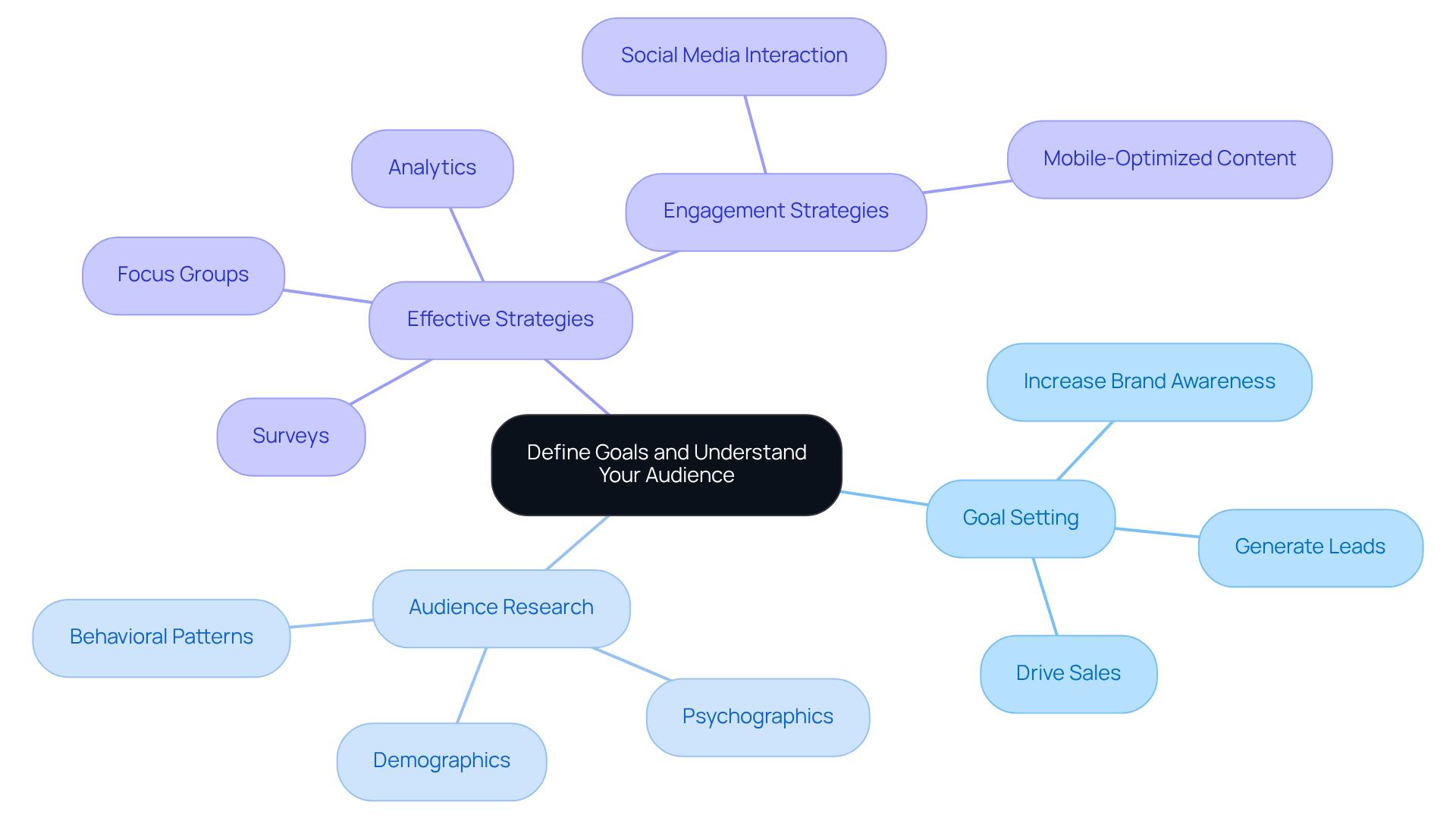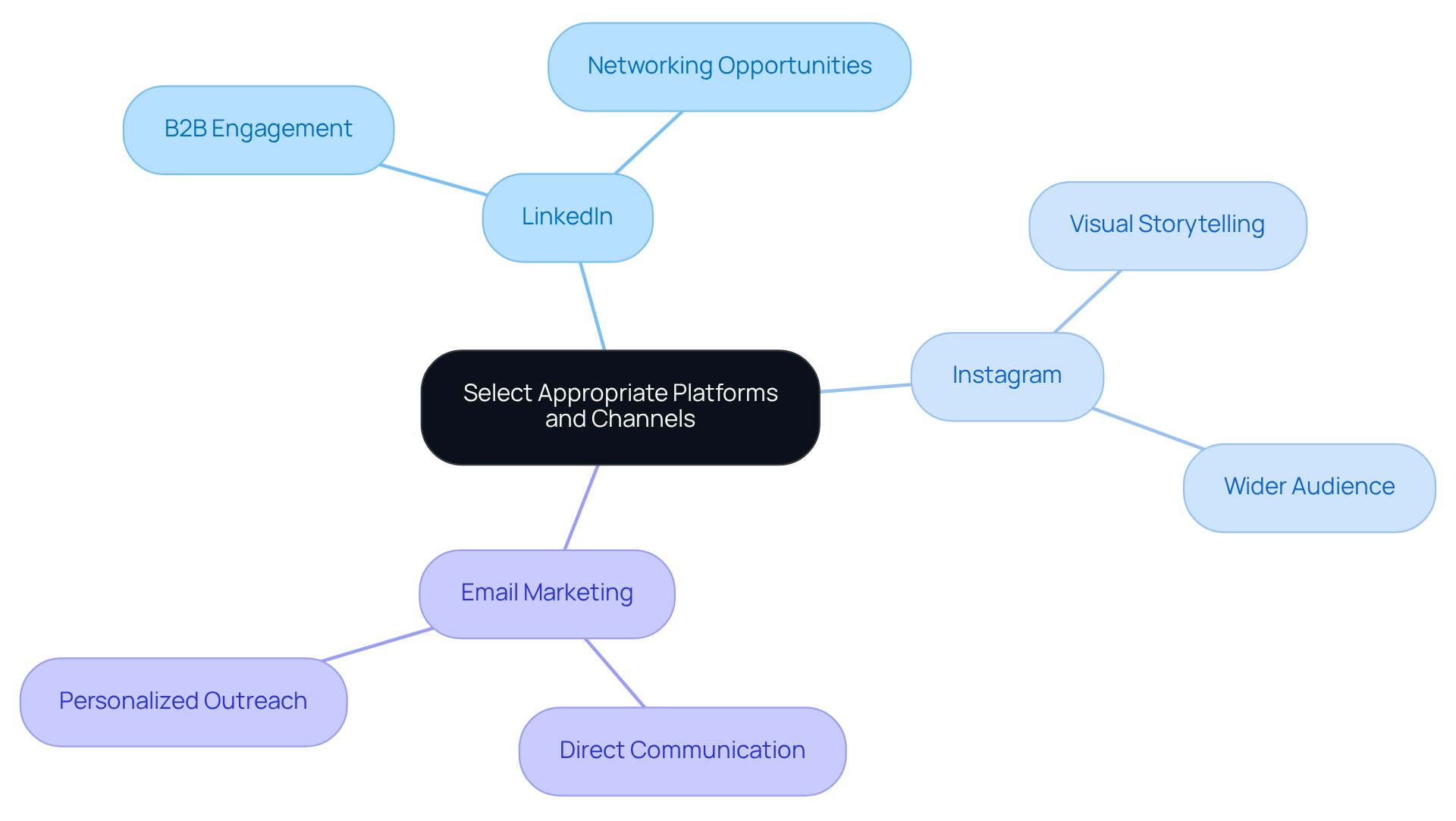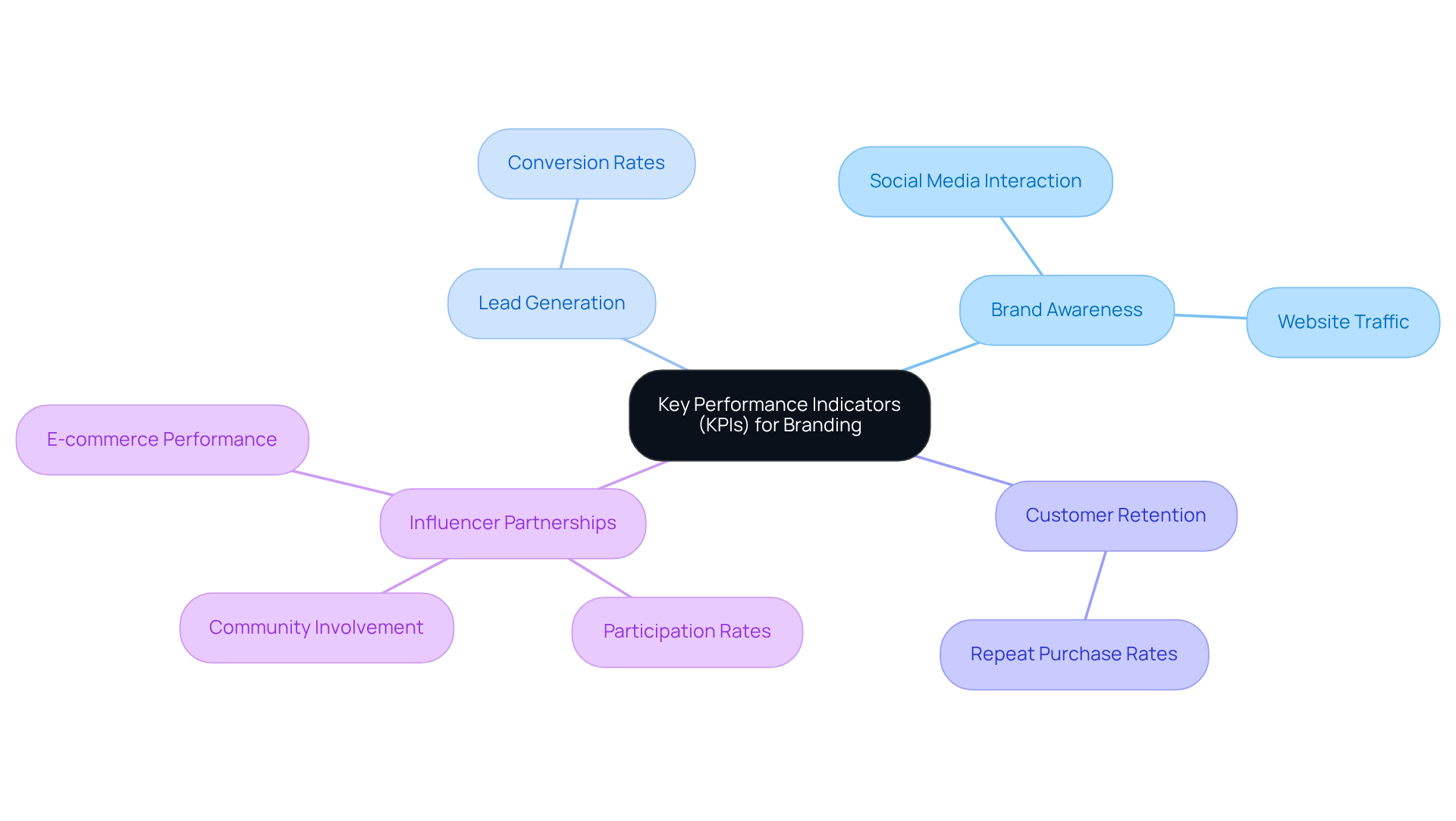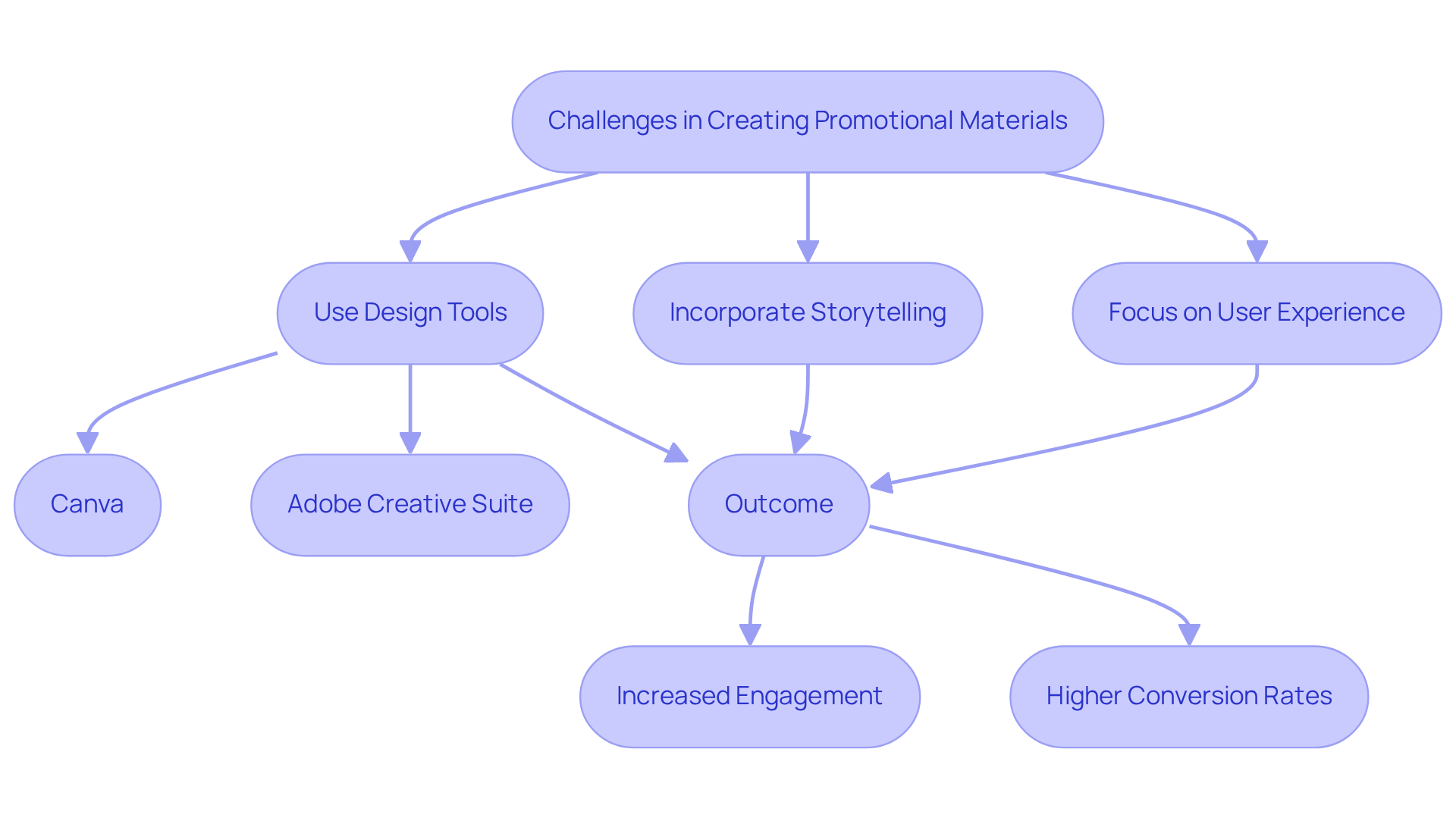Overview
To master effective branding campaigns, tech startups often face the challenge of defining their goals and understanding their audience. This can be overwhelming, leaving founders feeling uncertain about how to connect with potential customers. By conducting detailed research, however, startups can create tailored messaging that truly resonates with their audience.
Imagine the relief that comes from knowing you’re speaking directly to the needs of your customers. The article emphasizes that by selecting the right platforms and establishing key performance indicators, startups can not only enhance their brand visibility but also measure their campaign success. This process fosters meaningful connections with the target market, turning uncertainty into confidence.
As you navigate this journey, remember that you’re not alone. Many founders have been in your shoes, grappling with the complexities of branding. By embracing these strategies, you can transform your approach and build a brand that speaks to your audience’s heart. Let’s work together to ensure your message is heard and valued.
Introduction
Crafting a powerful brand identity can feel like a daunting task for tech startups striving to carve out their niche in a competitive landscape. Many founders grapple with the complexities of effective branding campaigns, often feeling overwhelmed by the challenges that arise. The stakes are high, as these emerging companies seek to unlock significant opportunities for growth and meaningful consumer engagement. However, the journey is not without its hurdles. From clarifying objectives to choosing the right platforms and measuring success, the path can be fraught with uncertainty.
Have you ever found yourself questioning whether your brand truly resonates with your audience? It’s a common concern among startup founders. The pressure to stand out in a crowded market can be intense, and it’s easy to feel lost in the noise. But you are not alone in this struggle. Many entrepreneurs share similar experiences, and it’s important to acknowledge the emotional toll these challenges can take.
So, how can tech startups navigate these complexities? The answer lies in building a brand that speaks to the heart of your audience. By focusing on authentic connections and understanding their needs, you can create a brand identity that not only stands out but also fosters loyalty and trust. At RNO1, we are here to support you on this journey, offering guidance and expertise tailored to your unique vision. Together, we can transform your brand into a powerful force that resonates deeply with your audience.
Define Goals and Understand Your Audience
To master effective branding campaigns, new ventures in technology often face the challenge of clearly defining their goals. This can feel overwhelming, especially when it involves pinpointing specific objectives, such as increasing brand awareness, generating leads, or driving sales. Once these goals are established, it becomes essential to conduct thorough research on the target group. This research should encompass demographics, psychographics, and behavioral patterns to develop detailed buyer personas. For instance, a technology business aimed at millennials might find it beneficial to emphasize social media interaction and mobile-optimized content. With 65 percent of consumers bypassing video advertisements, it underscores the necessity for engaging and pertinent messaging that resonates with this audience.
Effective research strategies for listeners involve utilizing tools such as surveys, focus groups, and analytics to gather insights into preferences and pain points. This ensures that branding efforts are tailored to meet the specific needs of the target market. A significant example is a technology company that aimed to capture 20% of the millennial demographic within a year. Through viewer research, they discovered that this group places a high value on sustainability and innovation, which directly informed their branding strategy and messaging.
Quotes from industry leaders reinforce this approach:
- Ralph Waldo Emerson emphasized that enthusiasm is vital for achieving greatness,
- David Ogilvy encouraged aiming high in marketing efforts.
By comprehending their market and adjusting their branding campaigns accordingly, technology companies can create impactful campaigns that resonate deeply with consumers. Remember, by taking these steps, you are not just building a brand; you are fostering a connection with your audience that can lead to lasting success.

Select Appropriate Platforms and Channels
Launching branding campaigns can feel daunting for tech startups. Many founders grapple with the challenge of setting clear objectives while trying to understand their target market. This foundational understanding is crucial; it shapes the choice of platforms and channels that will resonate most with potential customers. For example, LinkedIn is a fantastic space for B2B engagement, while Instagram shines in visual storytelling, and email marketing offers a direct line of communication. It’s essential for startups to focus on platforms where their audience is most active and receptive.
Consider a new business specializing in AI solutions. They may find significant traction on LinkedIn, where industry professionals are eager for insights and networking opportunities. On the other hand, a consumer technology brand could thrive on Instagram, showcasing product features through captivating visuals that appeal to a wider audience.
Adopting a multichannel strategy not only boosts visibility but also reinforces messaging across various touchpoints, creating a cohesive brand experience. A noteworthy example is an innovation company that launched a productivity app aimed at young professionals. By concentrating its marketing efforts on LinkedIn and Instagram, this new business achieved an impressive 50% increase in user sign-ups within just three months. This success illustrates the power of a well-chosen platform strategy.
By sharing these insights, we hope to inspire and support fellow startup founders in their branding campaigns. Remember, understanding your audience and selecting the right platforms can make all the difference in creating a meaningful connection.

Establish Key Performance Indicators (KPIs) for Measurement
Many technology ventures face the challenge of establishing clear Key Performance Indicators (KPIs) that align with their defined goals to effectively measure the success of their branding campaigns. This can often feel overwhelming. Key metrics can include:
- Brand awareness, which is measured through social media interaction and website traffic
- Lead generation tracked via conversion rates
- Customer retention assessed through repeat purchase rates
When scaling omnichannel brand ambassador programs, new businesses should also consider KPIs that reflect the effectiveness of their influencer partnerships. For instance, monitoring participation rates from influencer-generated content can provide valuable insights into community involvement and the overall effect on e-commerce performance. By consistently assessing these KPIs, new businesses can evaluate the performance of their branding campaigns and make necessary adjustments. If a branding campaign aimed at boosting brand recognition through influencer partnerships shows low interaction rates, it may be time to rethink the messaging or explore new influencer avenues.
Consider a real-world example: A technology company set a KPI to boost website traffic by 30% within six months. They utilized Google Analytics to track their progress. By analyzing user behavior, they identified content gaps and adjusted their strategy, ultimately exceeding their goal with a remarkable 40% increase in traffic. This approach reflects the innovative strategies employed by RNO1's Ryde initiative, which emphasizes the importance of community engagement and influencer marketing in fostering brand success.
We understand that navigating these waters can be challenging, but remember, you are not alone. Sharing experiences and insights can help us all grow together.

Create Compelling Promotional Materials
Creating engaging promotional materials for branding campaigns can feel daunting for technology companies that are striving to carve out a strong market presence. At RNO1, we understand this challenge and believe that a design-focused approach is essential at every touchpoint or interaction. This means crafting visually striking graphics, composing persuasive copy, and ensuring consistency across all platforms. Startups should highlight their unique value proposition, making sure it shines through clearly in their promotional content.
Utilizing design tools like Canva and Adobe Creative Suite empowers new businesses to produce professional-quality materials without needing extensive graphic design skills. In fact, 35.5% of content marketers turn to online tools like Canva to create graphics, showcasing its effectiveness. Incorporating storytelling elements can further enhance engagement, making promotional materials more relatable and impactful.
For example, consider a technology company that launched a new software product. They developed a series of promotional videos featuring user testimonials and key features. By sharing these videos on social media and their website, they experienced a remarkable 60% increase in engagement, generating significant excitement around their launch. This illustrates how effective design and strategic content can amplify visibility and interest in branding campaigns within a competitive landscape. Moreover, companies that prioritize user experience enjoy a 37% increase in conversion rates, underscoring the vital role of effective design in promotional strategies.
However, we recognize that startups often face hurdles, such as lengthy approval processes, which 34% of graphic design teams identify as a common issue. At RNO1, we address these challenges by streamlining our design processes, allowing our clients to concentrate on their core business while we manage the intricacies of design.

Conclusion
Mastering effective branding campaigns is vital for tech startups striving to find their place in a competitive landscape. Many founders face the daunting challenge of standing out, often feeling overwhelmed by the multitude of options available. It’s essential to recognize that by clearly defining goals and truly understanding their audience, businesses can craft tailored strategies that resonate deeply with consumers, fostering meaningful connections that go beyond mere transactions. This foundational approach not only enhances brand awareness but also nurtures engagement and drives sales.
In our exploration of branding strategies, we’ve highlighted key elements that are crucial for success—such as:
- Selecting the right platforms
- Establishing measurable KPIs
- Creating compelling promotional materials
Each of these components plays a significant role in ensuring that branding efforts are impactful and aligned with the unique needs of the target audience. Real-world examples illustrate how startups can harness research and creativity to achieve remarkable results, including increased user engagement and sales growth.
Ultimately, the success of a branding campaign hinges on a profound understanding of the market and a steadfast commitment to delivering genuine value. As tech startups navigate this journey, we encourage them to embrace these principles wholeheartedly. It’s important to continually adapt strategies based on performance metrics and to prioritize engaging storytelling in their promotional efforts. By doing so, they can cultivate a strong brand presence that not only stands out but also resonates with the ever-evolving technology landscape. Remember, you’re not alone in this journey; there’s a community ready to support you.
Frequently Asked Questions
What is the first step in mastering effective branding campaigns for technology ventures?
The first step is to clearly define goals, which may include increasing brand awareness, generating leads, or driving sales.
Why is understanding the target audience important in branding campaigns?
Understanding the target audience is crucial because it enables the development of detailed buyer personas, which helps tailor branding efforts to meet the specific needs and preferences of the market.
What types of research should be conducted to understand the audience?
Research should encompass demographics, psychographics, and behavioral patterns, and can include tools such as surveys, focus groups, and analytics.
How can technology companies effectively engage with millennials?
Technology companies can effectively engage with millennials by emphasizing social media interaction and mobile-optimized content, as well as addressing values important to this demographic, such as sustainability and innovation.
What is an example of a successful branding strategy based on audience research?
An example is a technology company that aimed to capture 20% of the millennial demographic within a year and adjusted their branding strategy to highlight sustainability and innovation based on their research findings.
What do industry leaders say about enthusiasm and marketing efforts?
Ralph Waldo Emerson emphasized that enthusiasm is vital for achieving greatness, while David Ogilvy encouraged aiming high in marketing efforts.
What is the ultimate goal of adjusting branding campaigns based on audience understanding?
The ultimate goal is to create impactful campaigns that resonate deeply with consumers, fostering a connection that can lead to lasting success.




